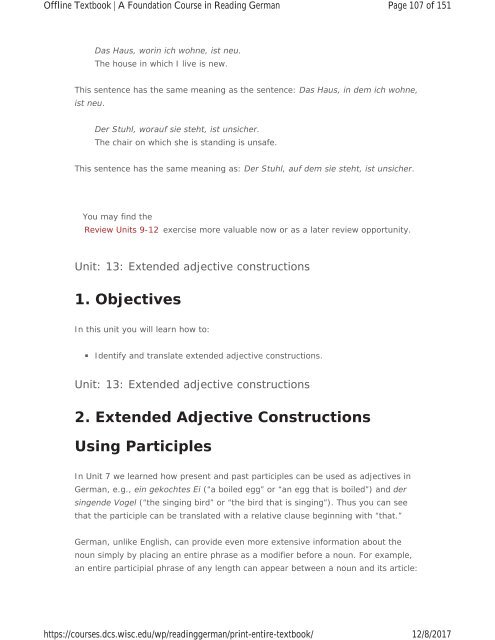A Foundation Course in Reading German, 2017a
A Foundation Course in Reading German, 2017a
A Foundation Course in Reading German, 2017a
Create successful ePaper yourself
Turn your PDF publications into a flip-book with our unique Google optimized e-Paper software.
Offl<strong>in</strong>e Textbook | A <strong>Foundation</strong> <strong>Course</strong> <strong>in</strong> Read<strong>in</strong>g <strong>German</strong><br />
https://courses.dcs.wisc.edu/wp/read<strong>in</strong>ggerman/pr<strong>in</strong>t-entire-textbook/<br />
Page 107 of 151<br />
12/8/2017<br />
Das Haus, wor<strong>in</strong> ich wohne, ist neu.<br />
The house <strong>in</strong> which I live is new.<br />
This sentence has the same mean<strong>in</strong>g as the sentence: Das Haus, <strong>in</strong> dem ich wohne,<br />
ist neu.<br />
Der Stuhl, worauf sie steht, ist unsicher.<br />
The chair on which she is stand<strong>in</strong>g is unsafe.<br />
This sentence has the same mean<strong>in</strong>g as: Der Stuhl, auf dem sie steht, ist unsicher.<br />
You may f<strong>in</strong>d the<br />
Review Units 9-12 exercise more valuable now or as a later review opportunity.<br />
Unit: 13: Extended adjective constructions<br />
1. Objectives<br />
In this unit you will learn how to:<br />
Identify and translate extended adjective constructions.<br />
Unit: 13: Extended adjective constructions<br />
2. Extended Adjective Constructions<br />
Us<strong>in</strong>g Participles<br />
In Unit 7 we learned how present and past participles can be used as adjectives <strong>in</strong><br />
<strong>German</strong>, e.g., e<strong>in</strong> gekochtes Ei (“a boiled egg” or “an egg that is boiled”) and der<br />
s<strong>in</strong>gende Vogel (“the s<strong>in</strong>g<strong>in</strong>g bird” or “the bird that is s<strong>in</strong>g<strong>in</strong>g”). Thus you can see<br />
that the participle can be translated with a relative clause beg<strong>in</strong>n<strong>in</strong>g with “that.”<br />
<strong>German</strong>, unlike English, can provide even more extensive <strong>in</strong>formation about the<br />
noun simply by plac<strong>in</strong>g an entire phrase as a modifier before a noun. For example,<br />
an entire participial phrase of any length can appear between a noun and its article:


















